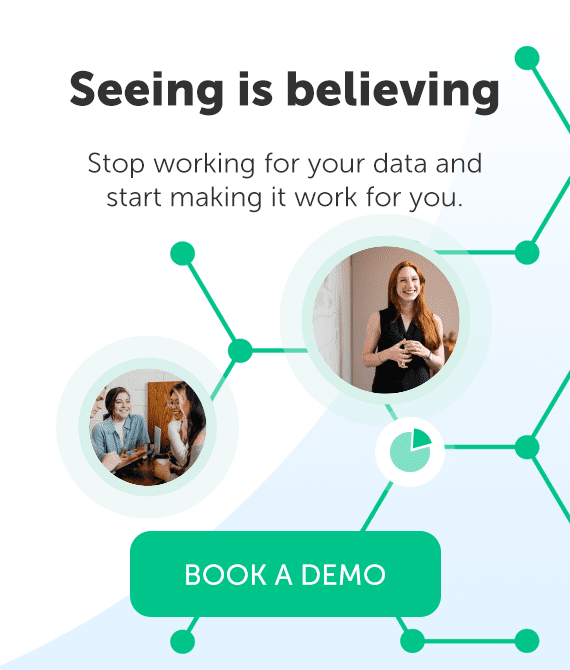Strong relationships are the backbone of every successful law firm. Whether it’s building trust with clients, nurturing referral networks, or fostering collaboration with partners, relationships aren’t just a professional formality; they’re the foundation of trust, growth, and opportunity in the legal industry. Business relationship data plays a pivotal role in helping your firm identify, understand, and grow these critical connections.
Relationships don’t just happen—they are cultivated through intentional effort, thoughtful engagement, and strategic insights. By truly understanding the connections within your firm’s network—how deep they are, where they intersect, and where opportunities lie—you can turn casual interactions into meaningful partnerships.
By shifting to a more strategic approach, your firm can uncover the hidden power of their relationship data, amplifying their impact through stronger client relationships.
Why business relationship data matters
Relationships have always been at the core of business success, particularly in the legal sector. Referrals, which account for a significant portion of law firm revenue, stem directly from the strength and depth of these relationships. According to industry insights, up to 60–70% of law firm revenue can be attributed to referrals, highlighting the direct correlation between relationship management and financial outcomes.
However, relationships are no longer just built through in-person connections or casual conversations. They now require intentionality, strategy, and data. Business relationship data provides a 360-degree view of your firm’s connections—helping legal marketers and business development teams make informed decisions, strengthen client relationships, and identify new opportunities.
From reactive to proactive: leveraging relationship data
For many firms, relationship management remains reactive. Questions like “Does anyone know so and so?” dominate discussions, while valuable insights are buried in silos, scattered across emails, spreadsheets, or individual memories. Relationship data changes this by centralizing information and offering actionable insights.
Key benefits include:
- Mapping connections: Gain visibility into who knows whom and how well, allowing your firm to identify key influencers and decision-makers within target organizations.
- Finding untapped potential: Identify opportunities to cross-sell services to existing clients or introduce new practice areas based on past interactions.
- Building credibility: Understand a client’s industry, competitors, and challenges to position your firm as a trusted partner, not just a service provider.
How to use business relationship data to amplify your impact
1. Develop a single view of relationships
Centralize data from various touchpoints—such as billing records, communications, and CRM systems—into a unified platform. This ensures everyone at the firm has visibility into the full spectrum of client interactions, preventing missed opportunities and fostering collaboration.
2. Enhance personalization
Use relationship data to create tailored messaging for clients and prospects. Knowing a client’s specific challenges and goals allows your firm to engage more effectively, delivering the right message at the right time.
3. Identify white space opportunities
Analyze your relationship data to uncover gaps where additional services or solutions could meet client needs. For example, are there practice areas your clients aren’t currently utilizing? Is there an opportunity to introduce a new team or service line?
4. Prioritize strategic relationships
Not all relationships are equal. Having the right data helps you determine which connections are most valuable, allowing your team to focus on high-impact opportunities and decision-makers.
Driving Cross-Selling and Building Strong Relationships with Data
Cross-selling—ensuring all applicable practice groups within a law firm are introduced to the client—is a critical use case for data-driven relationship building and account growth. Afterall, 80% of your revenue often comes from 20% of your clients.
To this effect, tools like Introhive analyze business relationship data to find new opportunities in the client data you already have. These insights help you identify untapped revenue in accounts where you have established relationships. This is done by combining billing, customer relationship data, and opportunity data to seamlessly spot opportunities to expand into existing accounts by cross-selling and upselling your products or services. This type of analysis also identifies accounts that don’t have incoming revenue in other lines of business. All together, these hidden opportunities in your data—which can be easily uncovered with the right tools—are “the white space” where you will find gaps in client needs that you can then work to fill with your products or services.
As an example, following the merger of Wilson Legal and Stanton Allen, and just 120 days after going live with Introhive, the new Wilson Allen firm realized the following results:
- A 584% return on investment from cost savings mapped to pre-meeting digest intelligence reports
- The platform enabled the merged company to identify and close cross-selling opportunities more efficiently by immediately bringing together two disparate data sets into one cleaned an enriched database (this also helped ensure an overall smoother transition into a single business unit, which can often prove difficult without a tool like Introhive)
- The simple use of the platform enabled Wilson Allen to reinforce to clients its value and power, creating new growth opportunities for the company’s services business
“Introhive has helped in identifying relationships that exist in other practices of
the business without the need to ask ‘who knows who.’ Specifically, it’s helped
with a cross-selling initiative for the CRM Practice into existing Wilson legal
Clients.” – Michael Warren, VP of Client Development and Intake Practice at Wilson Allen.
Conclusion
Relationships, whether with long-standing clients or new prospects, are the foundation of trust, loyalty, and growth. Growing your firm doesn’t always require chasing new clients—it starts with strengthening and expanding the relationships you already have.
When you leverage business relationship data, you can focus on understanding the needs, challenges, and goals of your existing clients and position your firm as a trusted advisor, not just a service provider. These meaningful partnerships lead to repeat business, increased referrals, and cross-selling opportunities that can power your firm’s long-term growth. The key is to turn the data you already have into a strategic advantage, using it to guide smarter decisions and foster lasting success.
Schedule a demo and take the next step toward smarter, relationship-driven growth—because your best opportunities are already in your network.
FAQ on business relationship data
What is business relationship data, and why is it important for law firms?
Business relationship data encompasses information about your firm’s connections, including client interactions, referral networks, and partner relationships. For law firms, it is essential because it provides actionable insights to strengthen client relationships, identify growth opportunities, and drive revenue through referrals and cross-selling.
Can business relationship data help with cross-selling?
Yes. By analyzing existing client data, law firms can uncover white space opportunities—areas where clients aren’t using your services but could benefit from them. This approach helps introduce additional practice areas and strengthens the client relationship.
What tools can help law firms analyze relationship data?
CRM-integrated solutions like Introhive can centralize, analyze, and provide actionable insights from relationship data. These tools go beyond simple CRM capabilities by offering AI-powered suggestions, relationship scoring, and visualization of key influencers and decision-makers within a client’s ecosystem. Firms that adopt these technologies can develop more targeted engagement strategies to grow their existing accounts.





